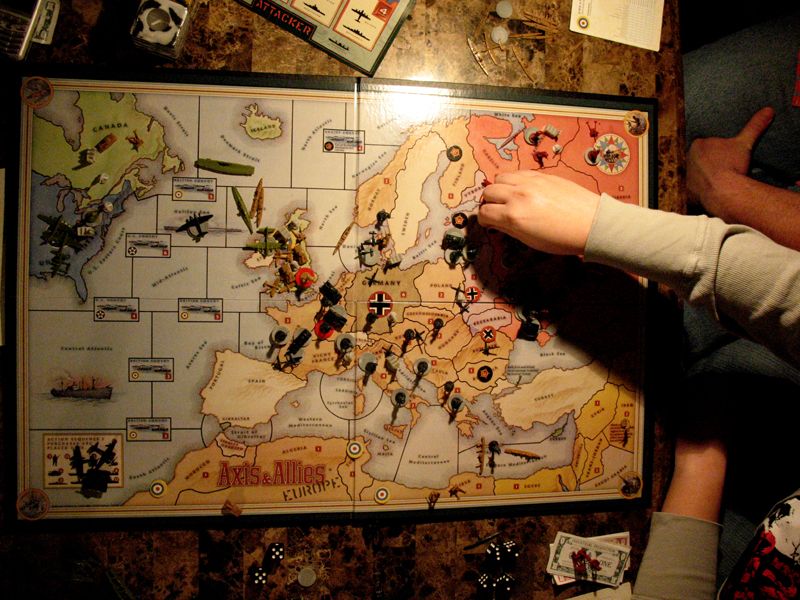30 Dec 2024—This is an updated version of my October blog post. The original conatins several factual and mathematical errors, but is archived here for posterity. Where the the text is improved, the expert feedback and patience of CyberChronometer may be credited. Where confusion persists, the fault is my own.
Thermodynamics for Game Design
In thermodynamics, a reversible process is one that happens near equilibrium and with minimal dissipation. In a reversible process, a tiny change in some variable can be put back with the same effort that made it. Phase boundaries are well-modeled as reversible processes: the amount of energy it takes to melt an amount of ice is the same amount it takes to re-freeze it. Strictly, no process is truly reversible, but a model of a reversible process gives us the most efficient version of it, and maybe clues about optimization.
 A glass of ice water, Cleiton Andrade Andrade, CC0 via Wikimedia Commons.
A glass of ice water, Cleiton Andrade Andrade, CC0 via Wikimedia Commons.
By contrast, an irreversible process loses some energy to entropy. Friction makes mechanical systems irreversible: the energy to move something is not the same as the energy to move it back because friction takes the same toll each time. Entropy always increases.
Even though entropy always increases in general, we can control it locally. Consider that mixing two liquids increases the entropy of the system. Even after mixing, we could still separate them, say by distillation. Distillation is pretty good, but probably consumes more energy than the mixing did. In general, unscientifically, mixing things is easier than separating them again. Entropy wants to increase.
What does this mean for my character sheet?
Which brings me to the unhappy subject of bookkeeping. Essentially, writing things down is easy (increases entropy or is entropy-neutral) and erasing them is difficult, or at least tedious (decreases entropy). So where we have a value that’s going to move up and down, we should write the more common direction and erase the less common one. And if we can help it, we should avoid or change the way we write. I’ll see if I can illustrate with some examples.
Hitpoints (Dungeons & Dragons)
Hitpoints are the most annoying thing to track in D&D. Because the numbers are so high, it’s infeasible to make a mark for each hitpoint. Instead, we write the totals, only to erase and re-write them completely, over and over. This also happens constantly in D&D. Every missed save, every round of combat, every healing spell and potion, every short and long rest. The space allotted for hitpoints on most character sheets is small and the paper wears thin fast.
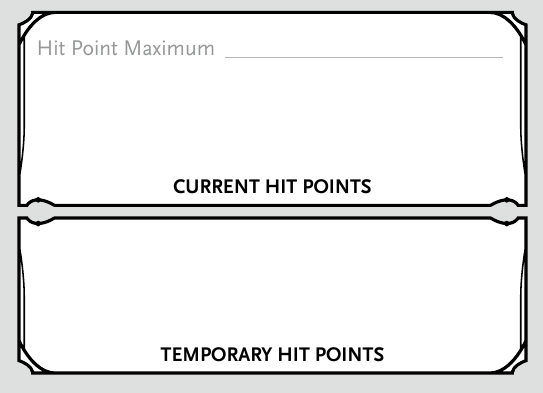 The hitpoints section of the official 5e D&D character sheet.
The hitpoints section of the official 5e D&D character sheet.
Wealth (Dungeons & Dragons)
Money in D&D amplifies the problem of hitpoints by being several numbers (copper, silver, gold, etc.), but regains some efficiency by only decreasing rarely (often between sessions or at the beginning or end of a session) and generally being easy to ignore.1
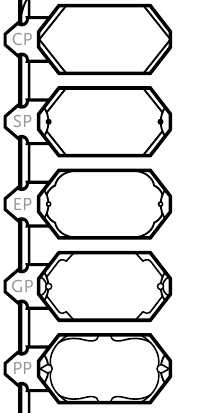 The money section of the official 5e D&D character sheet.
The money section of the official 5e D&D character sheet.
Inventory (Troika!)
Troika!, relatively uniquely, makes the order of items in your backpack relevant in play. This is laborious, as instead of simply tracking a number up or down, we now have to account for an enormous number of possible orders (to say nothing of the pack’s contents). We can directly quantify this increase in entropy2 through information theory: if we only care to count the items in our pack, there are possibilities. If we care what order they are in, there are possibilities, almost 40 million times more. Obviously, the cognitive load does not increase linearly with entropy, but it does increase. And of course, our main concern here isn’t psychological, it’s practical: now when you pick up an item, you may find yourself having to erase and rewrite, or at least re-number, every other item in your pack.
Reversible Processes and Equilibrium
We can look at how other games have solved or avoided these problems, even if they didn’t consciously apply a thermodynamic lens.
A lot of these examples use dice. For our purposes, a thrown die is in equilibrium: it’s just as easy for it to land in one state as another, and “frictional” forces are negligible. Changing the number on top (intentionally or unintentionally) is entropy neutral, while changing a written number is going to cost energy.
By extension of this generalization, any “unfixed” process is generally “in equilibrium.” I hope you’ll see what I mean.

Ammo (Gamma World 7e)
Nobody likes tracking ammo. Gamma World 7e went a long way to making it painless: you either have ammo or you don’t, and if you use ammo more than once in a combat then at the end you’ll be out. (I have praised these rules for their simplicity before.) Part of the elegance of these rules is that they reduce ammunition to a binary: the smallest value that can be tracked. In general, smaller quantities have lower entropies, fewer possible states.
Spell Slots (Dungeons & Dragons)
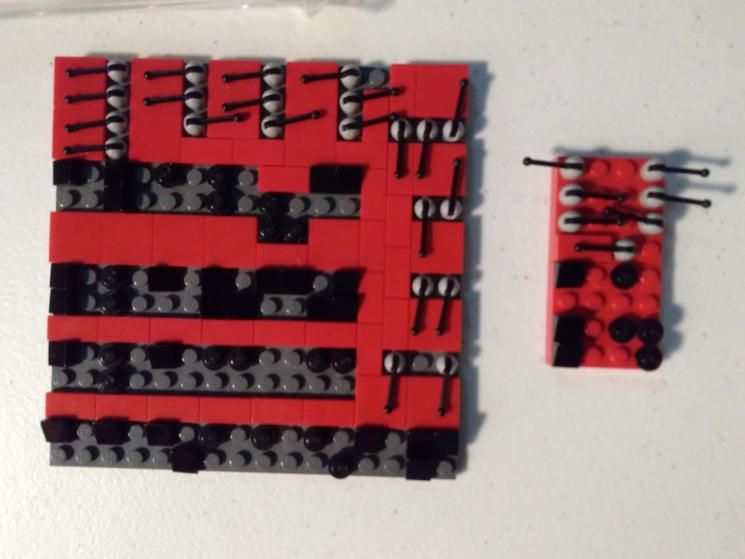 Image source is a friend of an Internet friend, who gave permission to share it in case it gives people ideas about accessibility.
Image source is a friend of an Internet friend, who gave permission to share it in case it gives people ideas about accessibility.
This Lego character sheet for a visually-impaired player uses toggles extensively to track spell slots. My understanding is that the “braille” is imperfect, but mnemonic.
The toggles are effectively reversible, compared to the entropy of the classical pencil-and-paper character sheet. You can toggle that antenna piece back and forth hundreds, maybe thousands of times. You can erase your paper maybe a dozen before tearing thru it. (This is imprecise phrasing, technically wear is distinct from entropy. Still, the “destructiveness” of an action can be a loose proxy.)
Wealth (Savage Worlds)
Many games treat money as a character statistic, a mechanic that determines in play (via a check or test) whether you have enough money. In Savage Worlds, for example, you roll to see if you can afford something or not. If you succeed, it’s yours. If you fail, you still have the option to buy it, but it will wipe out all your wealth if you do.
There are a few things at work here.3 First, wealth becomes roughly binary: “enough” or “not enough,” and as we’ve established, binary things are easiest to track.
By moving the activity to a (relatively) stateless die-roll, there is no need (or rarely a need) to update the value after an expense. Of course there is no “memory” for the tests either now, which can be explained away in fiction if necessary (“spaceships were on sale last time,” “it has to do with the value of the Euro in Estonia,” etc.)
Wealth (Monopoly)
Nobody plays Monopoly with pencil and paper and double-entry bookkeeping. You just have physical representations, “Monopoly money,” that you pass back and forth.4
In addition to being satisfying to handle, this means that the “state” of the money, which is to say, its current “owner,” is trivial to change; it is always “near” equilibrium. It does have an owner, but perhaps in our physical model, this could be analogous to a phase change that has very little latent heat. It takes little effort to put the whole system back into a new phase.
 kschneider2991, CC0 via Wikimedia Commons.
kschneider2991, CC0 via Wikimedia Commons.
Life Total (Magic: the Gathering)
Life totals in Magic change as much as HP in D&D, but much faster. In almost every game, one player’s life total goes from 20 to 0 in around as many minutes.
Striking a number is simply making an additional mark, and so just as efficient as writing it in the first place. At high levels of Magic, life pads are used to track these changing numbers, along with other notes. Because information is not ever lost in this system, it can even be used to reconstruct complicated parts of game history, or to reconcile multiple versions of events.
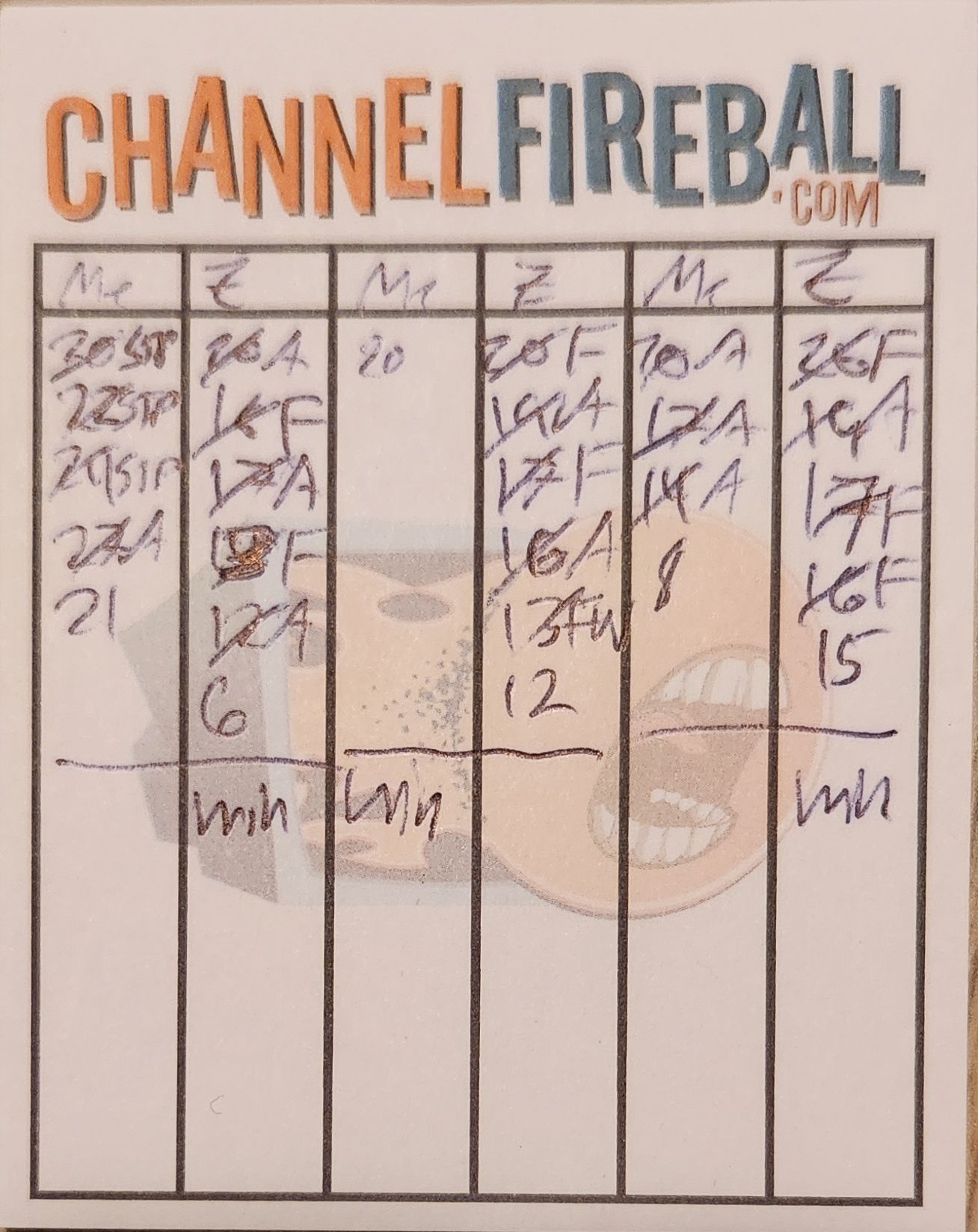 A match record on a life pad. 'STP' is Swords to Plowshares, 'A' is Attack, 'F' is a Fetchland, and 'FW' is probably Force of Will.
A match record on a life pad. 'STP' is Swords to Plowshares, 'A' is Attack, 'F' is a Fetchland, and 'FW' is probably Force of Will.
After the game is over, you can discard the page. This works because the cost of lowering entropy is only incurred when the information is destroyed. If the whole page is discarded, the information is still there, the cost is deferred to the municipal waste collection system.
This is of course wasteful and allows the possibility of eventually running out of paper. For convenience, some players use Boogie Boards, which record information on a bistable LCD. The LCD stays right around a phase change, so it can be reversed easily.
Many Magic players take the “equilibrium” of a die roll to its natural conclusion with the “spindown” life counter, a d205 numbered so that sequential numbers are physically adjacent. Just leave it with the current value face up and bump it a few faces when the value changes. But if you shake the table, there is no way to recover: the phase has changed.
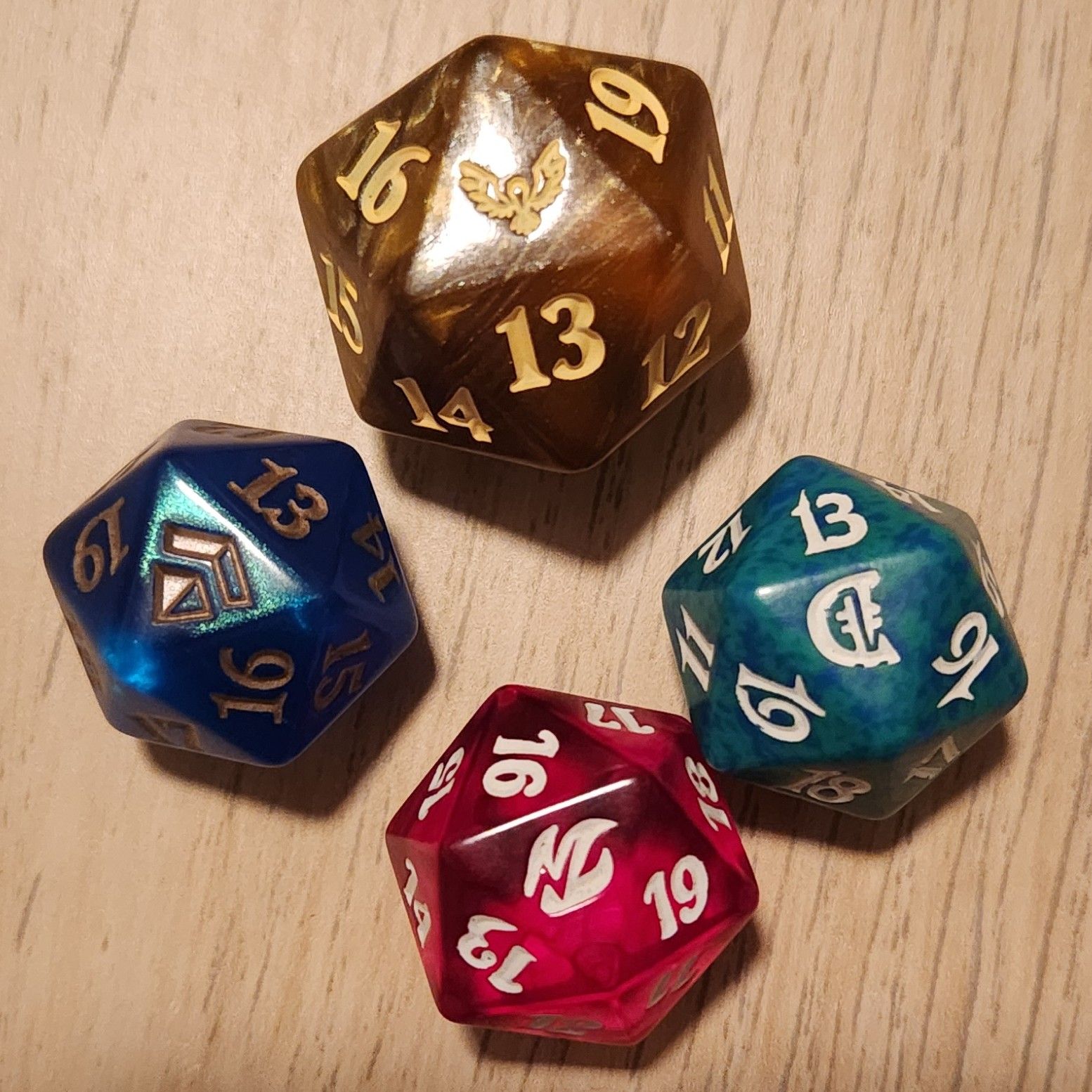 Some 'spindown' life counters. Here, the miscellaneous symbols are all '20.'
Some 'spindown' life counters. Here, the miscellaneous symbols are all '20.'
Before Wizards settled on the ubiquitous spindown for casual play and promotional purposes, they did briefly experiment with spinners. (Indeed, most third-party life-tracking devices are still of this type.) Like dice, a spinner could be used for randomization, but unlike dice, a “poorly constructed” spinner sticks in usefully persistent ways. It’s more “reversible” than making a mark, but less “in equilibrium” than a thrown (or sitting) die, and in principle, it could be “tuned” to any point between these two extremes. In practice they’re a little bit fiddly, perhaps not as tactilely satisfying as the spindowns, and perhaps a touch too expensive to give away so cheap. But they’re not bad.
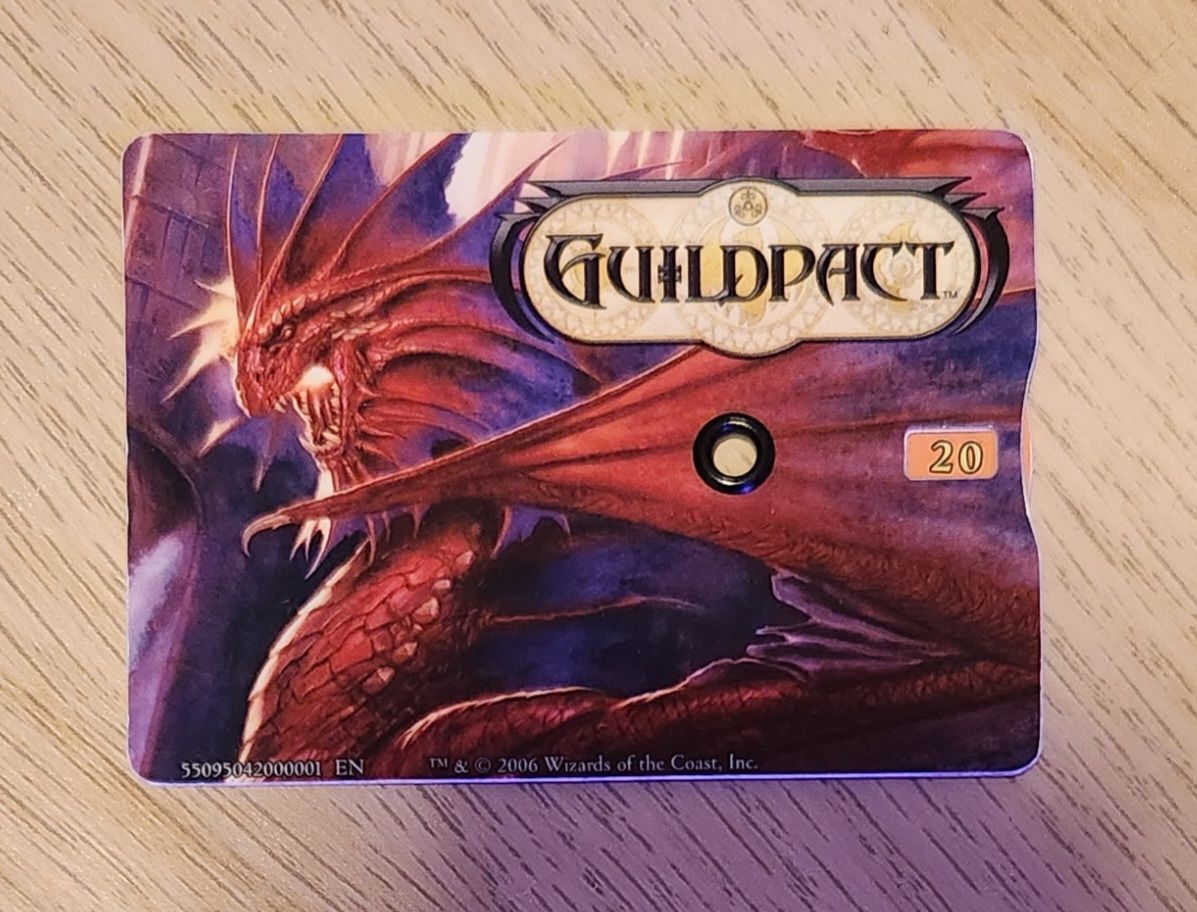 Official Magic 'spinner' (not spindown) life counter.
Official Magic 'spinner' (not spindown) life counter.
I should also mention that some players use phone apps to track life totals. This seems inelegant to me: it emulates the “phase change” of a spindown counter even though it could have the “delayed phase change” of a boogie board. Still, virtual solutions grant us some of the most flexibility here, if for example you have a nonstandard life total (i.e. 40 life in Commander), too many players to reasonably be tracked by one individual (multiplayer, commonly Commander), and the culture of play is casual enough that reconstruction and study is not critical (once more, Commander, although this could be a feature if it were desired). These apps can automate other things too, like rules look-ups, match reporting, and the emulation of otherwise digital-only features.
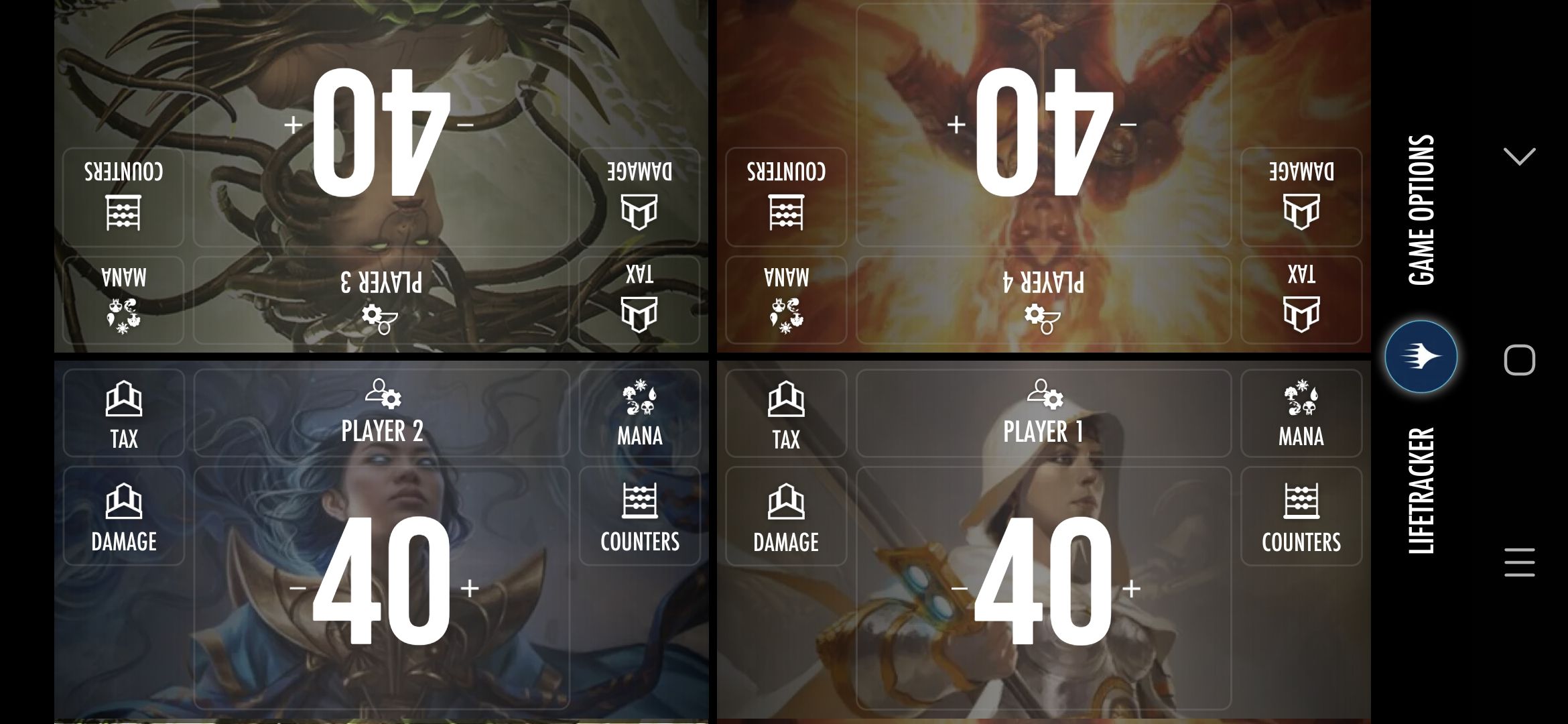 A screenshot of the current official Magic life tracking app.
A screenshot of the current official Magic life tracking app.
Counting Up (Kintsugi)
David Schirduan’s tiny game Kintsugi lets you improve any skill from 2 to 6, after which that skill is unusable. A perfect way to track these values is with tally marks. The numbers are small, and they only move in one direction. Nothing is ever erased in Kintsugi, only built upon. If the skills decreased instead, it would become difficult to track. If the skills went up to say, 20, then again they would become tedious to track (albeit more for psychological reasons, as they still would not decrease).
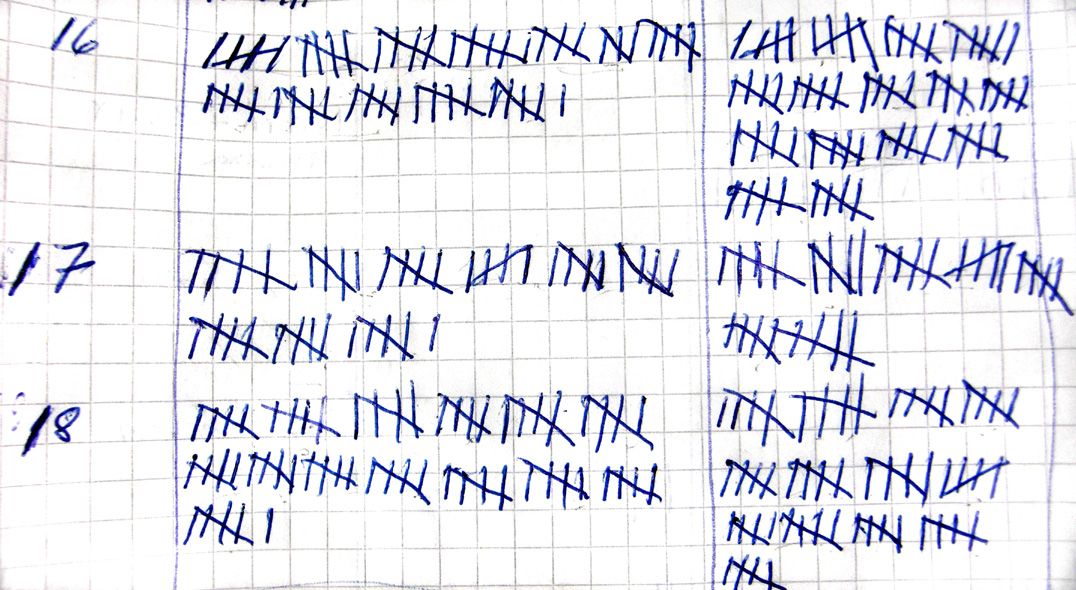 Tally Marks, Gunnar Creutz, CC0 via Wikimedia Commons.
Tally Marks, Gunnar Creutz, CC0 via Wikimedia Commons.
Filling Bubbles (hit dice sheet)
In contrast to PC hitpoints, enemy hitpoints in D&D tend to only move one direction. This lets us easily track them on a disposable sheet.
But hitpoints are still “lost,” so conceptually this takes some reframing. In solid-state physics, we often care more about where there isn’t an electron than where there is. The solution is simple: we define this lack as its own (quasi)particle, a “hole.” Now the math is more manageable.
Applying this inversion to hitpoints, we can leave discrete gaps for hitpoints, and mark when they are gone. Which is to say we leave a line of bubbles to be filled in.
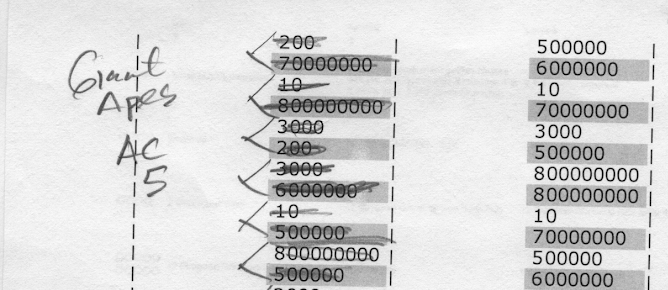 6 defeated giant apes, Jim Pacek, CC BY-NC-SA 3.0 via Carjacked Seraphim.
6 defeated giant apes, Jim Pacek, CC BY-NC-SA 3.0 via Carjacked Seraphim.
Inventory (Mausritter)
As we saw with Monopoly, physical objects are better than writing for many of these purposes. Consider Mausritter, which uses item and condition cards to intuitively and simply track inventory. Because they are never fixed in place, they are always efficient to rearrange. If we were to say, glue them, then we would have forced them into a “phase,” and we can no longer model the system as reversible.
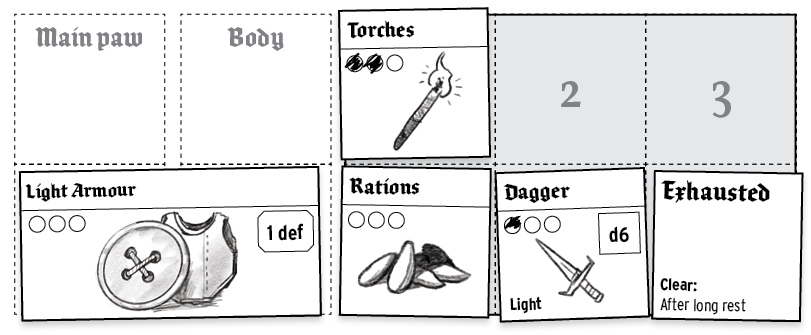 Snippet from the Mausritter rules.
Snippet from the Mausritter rules.
Note also that there is space to mark the cards themselves! By restricting these irreversible processes to smaller components, we allow ourselves to more efficiently pay the costs of entropy. The whole character sheet need not be modified or replaced as irreversible processes occasionally need to be undone, only the smaller system to which those changes were confined. If one card wears through, we do not lose the whole character sheet, as only that card has been “paying” the entropic cost. If we fully consume an item,6 we only need to discard the used components (again, deferring that cost). Even note that the marks on the item cards are already “inverted:” potential uses that count up instead of potential wear that counts down!
Anne of DIY & Dragons also has a more coherent and well-read post singing the praises of Mausritter and its inventory system.
Stickers (Magic: the Gathering)
Can we have the stability of an irreversible process, like glue, and the flexibility of a reversible one, like Mausritter? Can we do this chemically without custom or bulky parts? Well, I can’t, but if you have the resources of Wizards R&D and a cooperative adhesive vendor behind you, you kind of can!7 (An episode of Mark Rosewater’s Magic: The Gathering Drive to Work Podcast goes into some of the technical details and negotiations with their suppliers, but I can’t recall which. Possibly, one of the four-part “Unfinity Design” series.) I don’t have anything to add, except that I thought it was interesting.
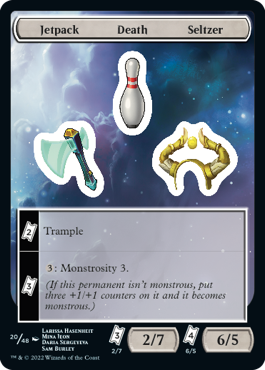 An Unfinity sticker sheet.
An Unfinity sticker sheet.
Mementos (Stickers, Yazeba’s Bed and Breakfast)
We’re into full-aside territory here, but you can also leverage these irreversible processes to their natural ends. The memento stickers in Yazeba’s Bed and Breakfast are permanent, which changes the way they feel (emotionally). Like sewing a patch to a vest or bumper-stickering a car: making it more your own through lighthearted-but-permanent defacement.
 In loving memory, my old tablet case.
In loving memory, my old tablet case.
Keepsakes (Paperclips, Yazeba’s Bed and Breakfast)
Simple mechanical devices to hold pieces of paper together temporarily are already commonly available, and also used in Yazeba’s Bed and Breakfast: paperclips! In Yazeba’s, the simple inclusion of the keepsake is the goal, but as long as we can encode any relevant information along an edge,8 paperclips can be used to “hold” the relevant arrangement of pieces, or more simply as pointers along a track.
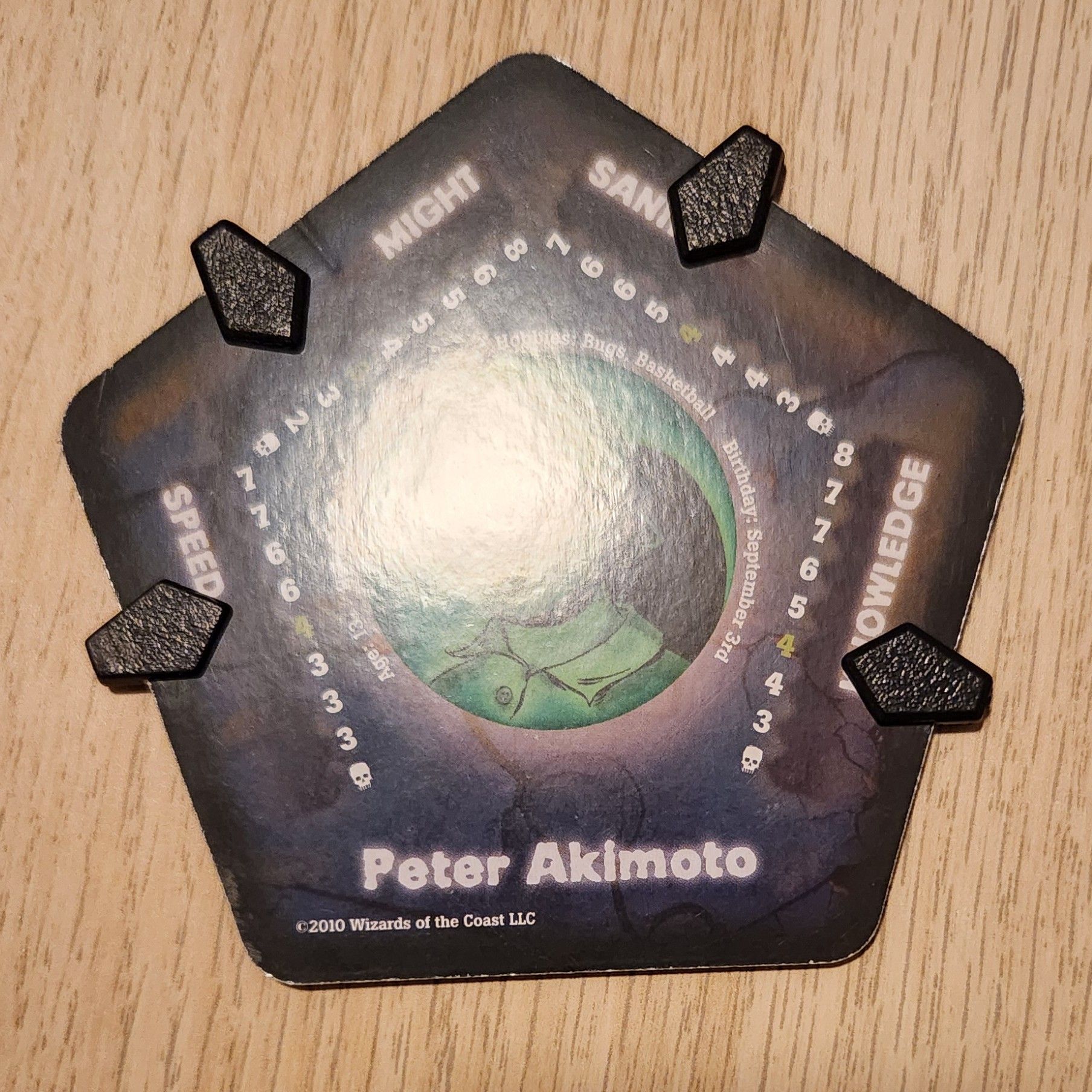 Four paperclip-like trackers representing a character in Betrayal at the House on the Hill.
Four paperclip-like trackers representing a character in Betrayal at the House on the Hill.
Photography (Axis & Allies)
One weakness of these state-less designs is that by maintaining an equilibrium, they never become “stable.” Which is fine if your table is steady and you can “reset” between sessions. But what if some information needs to persist? Recording information requires us to increase entropy.9
The game board of Axis & Allies is immeasurably higher-entropy than a character sheet: a full political map of the world in 1942 with figures for all different kinds of troop deployments by multiple players. And the game is long, long enough that it needs to have breaks. And large, large enough for a cat to walk across.
We could consider a few mechanical solutions: suction cups, adhesives, the divots of a “Chinese Checkers” board, the pegs of a Cribbage board. But all of these bring us further from our efficient ideal, and negatively affect gameplay. We expect players to need to move pieces much more often than they need to record the game state, so it makes sense to prioritize that process.
Games played slowly at a high level often have specialized rules for adjournment. These do not account for the existence of pets, children, earthquakes, forklifts, and other agents of entropy.
We could instead carefully note the position of every piece and then reconstruct the game state. This is undoubtedly the right decision. Unfortunately, we’re only doing it because the game state is already complex, so the process will necessarily be tedious and error-prone. With the advent of digital cameras, at least half of that work can be easily automated. (Leaving only the reconstruction process on the next day.)
Conclusions
Put scratch space on your character sheets. More than you think you need. Leave room for things to be written and re-written. Make it easy to transfer to a new sheet when the old one is full.
Segregate high-entropy systems from each other. Information density is good, but creates “fragile” systems. A one-page resume is good and a short cover letter is better than a long one,10 but if the cover letter were part of the resume, you’d have to edit the resume with every application.11
Avoid tracking things at all when possible. Make your character state-less; use game mechanics to determine numbers as-needed and discard them when finished (e.g. use a “strength check” instead of spending “strength points”). This takes full advantage of the near-reversibility of dice-rolling.12
Keep numbers small. The smallest number that can be tracked is a true/false value, a Boolean, a toggle switch.
If numbers don’t need to be preserved for multiple sessions, represent them with physical counters or dice. If they might, think about paperclips before pencils.
Conversely, if a value is going to be permanent, consider more permanent solutions. Write, sticker, strike, fold, tear.
Reframe numbers to count up where possible. It’s easier to make marks than to unmake them.
Develop physical tools. These let you track things with systems at or near equilibrium, which take less effort to update. Be aware that these systems are generally “unstable” though. Information is easily lost between sessions or via physical disruptions.
Develop digital tools, which effectively emulate the benefits of physical tools with the additional ability to manage complexity. Automate the worst parts.
Get some spindowns. They’re cool and good to have. In my informal polling,13 most Magic players have none, two, or 12+, and Wizards has done a good job making them easy to get hold of.
Hey, what about my character sheet?
If you’re only playing an existing game, not designing fresh, you may wonder what to do with this. Let’s move the values that change frequently off of the character sheet and consider them separately.
- Spell slots are Boolean, so let’s mark them with half-marbles when they’re unused. “Spending” the half-marble to cast a spell is satisfying, and neatly fails to distinguish between spells slots that are unavailable and spell slots that have been used already (if this is a concern).
- If the table is amenable, let’s track currency with Monopoly money. Anecdotally, physical representations encourage liquidity at the table, compared to written numbers. Otherwise, track it on its own sheet, perhaps a sticky note.
- If you use ammunition a lot, then a spindown might be good (especially if you’re using rules around recovery after combat, etc.) Otherwise I’d recommend a row of bubbles to fill or a number of tally marks to draw.
- Hit Points are still the most difficult value. You could feasibly borrow any of the techniques used for tracking Magic life totals, but I think the best might be the least convenient: a life pad, or separate sheet of lined paper. As life totals move up and down frequently and can be hotly contested, having this record provides some peace of mind, and an opportunity to reflect on the hardships of a character’s life. If you already take notes on lined paper, perhaps you could fit this running total in the margins.
- When you’re finished with a session, be sure to record these numbers in your notes, which are far more stable than even a rubber-banded bundle of funny money. A standard format can help with this (e.g. “end of session: 0 spell slots, 3 HP, 20 gp, 10 cp”).
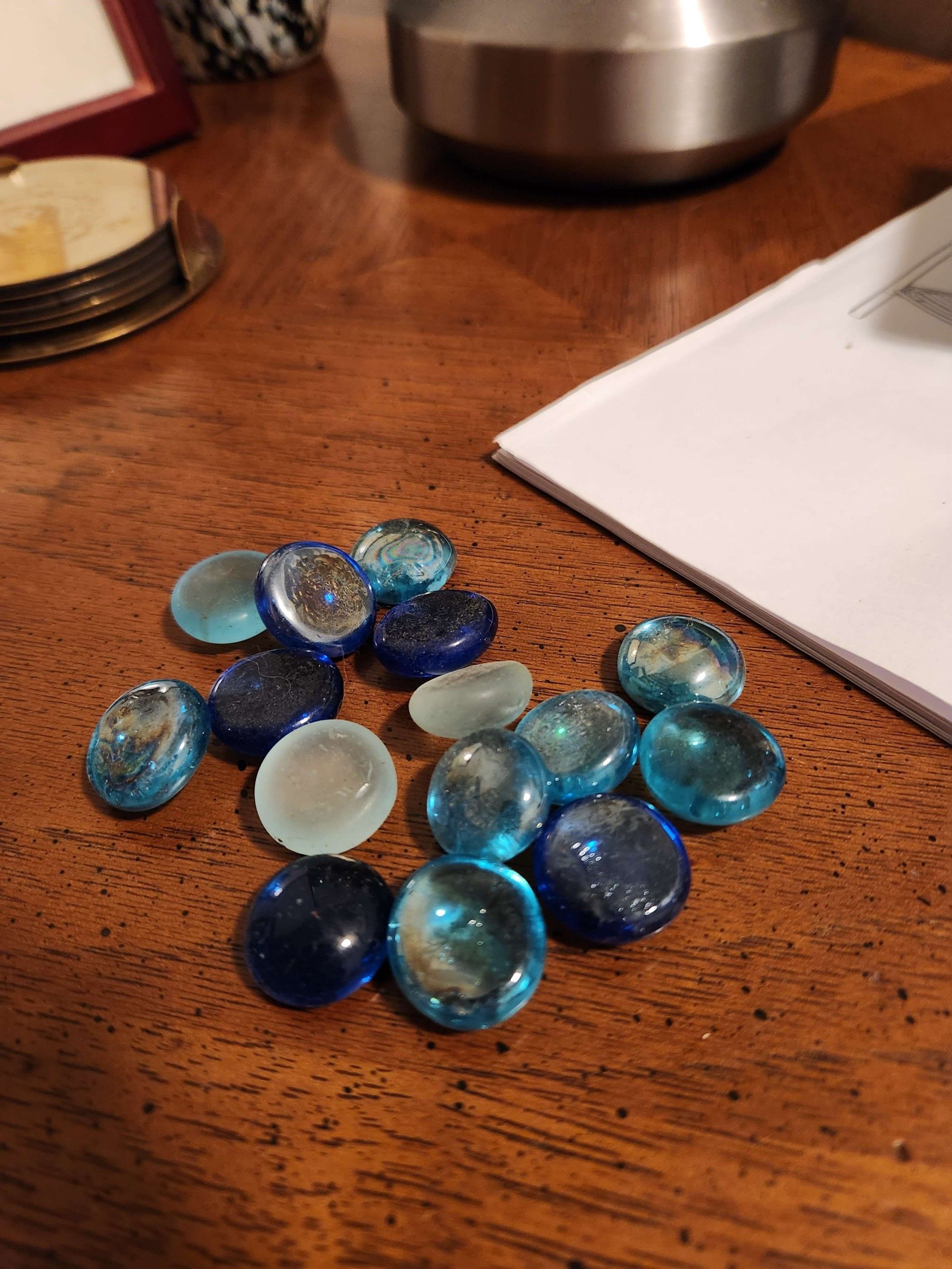 You know, half marbles. Aquarium stones. Flat beads. Bobble-glass. Life counters. Witch weights. Fairy pebbles.
You know, half marbles. Aquarium stones. Flat beads. Bobble-glass. Life counters. Witch weights. Fairy pebbles.
Ignoring a value or rule completely is generally the most efficient solution, if trivial.↩︎
“Entropy” the thermodynamic concept and “entropy” the information theory concept are the same thing, but I am being slightly lazy here.↩︎
The Savage Worlds implementation also has that delightful “yes, but…” replacing the binary “no,” but that’s not the focus of this piece.↩︎
In the interest of full disclosure, my current employer is strongly invested in the idea of cash as a physical object. So I guess, that could be a personal bias.↩︎
Theoretically, a spindown is a perfectly fine d20. But, as all the large numbers are on one side and all the small numbers on the other, if there are any biases or imperfections in the die, those effects could be magnified. Or if you don’t trust your players, they might be easier to cheat with. There is also a contention that they might be more likely to exhibit those biases, not being manufactured with rolling in mind. I say go ahead and roll them. They’re bigger than other dice, and satisfying, and my other dice aren’t exactly Game Science anyway.↩︎
Indeed, this is the most likely scenario in Mausritter, as the cards generally do not “recharge.”↩︎
I do not know the implementation details, but I suspect they might be similar to how Post-It notes work.↩︎
On a first pass, I cannot tie this edge-limit back to my big idea, but it’s worth noting. Edges and surfaces are dynamically relevant in processes like crystal growth, so there could be something spurious there. Maybe we can include spinners in this analysis? Anyway, you’ll only get to use this four times on a normal character sheet (once along each edge), so save it for important stuff.↩︎
This is not strictly true, but it’s how I think of it. Recording information can be entropy neutral, but the “cost” is paid when that information is destroyed (i.e. the game is put back in the box). So a more complex game-state has more potential information to be lost. This is about at the limits of my articulation, but it’s probably not super important for these examples.↩︎
I’m told people don’t write cover letters anymore. I don’t think they’re necessary, but if there’s space for one, I’d rather have something there for anyone who does want to read it, and they’re not onerous to write.↩︎
By contrast, some people do recommend this. I think that’s dumb.↩︎
Aesthetically, you may prefer to do away with dice-rolling completely. This is also valid. Ask, what is uncertainty adding to this situation? Is this a fun thing to track at all?↩︎
My formal polling was a failure. Follow me on Mastodon, if you can figure out how, I guess.↩︎
